Using a national data set, we find that over half of the people held in jail pretrial because they can't afford bail are parents of minor children.
by Wendy Sawyer,
August 15, 2018
Every day, 465,000 people are held in local jails even though they have not been convicted; legally, they are presumed innocent. Many are there because they cannot afford the money bail bond set for them. The harms of pretrial detention are well-known, both for defendants and for the juridictions that lock them up. But what about the harms of pretrial detention for families?
Previous research has estimated the number of incarcerated parents and the number of children who have parents behind bars. It’s a bit trickier, however, to estimate how many of these families are impacted specifically by pretrial detention or, even more specifically, by unaffordable money bail. We set about to answer this question.
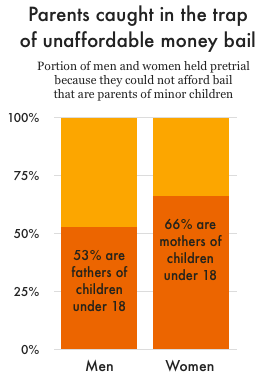
We analyzed the most recent Survey of Inmates in Local Jails to find that over half of the people in jail who could not make bail were parents of children under 18. Of the women who could not meet bail conditions, two-thirds were mothers of minor children, while just over half of the men were fathers. (See a table with all of our findings below.) Although this survey was last conducted in 2002, it remains the most recent national data on the subject available.
These results are generally consistent with national estimates of parents in the prison population. The Bureau of Justice Statistics (BJS) reports that 52% of people in state prison and 63% of those in federal prison were parents of minor children in 2007, although the share of mothers among women in pretrial detention is slightly greater than among women in prison.
Two smaller but more recent studies suggest that the impact of pretrial detention on families may be even greater than the two national BJS surveys indicate. Because of their small sample sizes, these studies are not generalizable, but they offer a glimpse of the how changes in jail populations may have impacted families since 2002, when the national data was last collected. In particular, since 2000, pretrial detention has increased by 31% to make up about two-thirds of the overall jail population, while the number of convicted people held in jail has actually fallen. Over the same 16 years, the jail incarceration rate for women has risen 26% while the rate for men has fallen by 5% — a significant trend when we consider that women are more often the primary caregivers of children.
First, in a 2016 study, researchers from George Mason University surveyed pretrial defendants, including both defendants who were detained because they did not post money bond and those who were released to pretrial supervision. Their analysis found that 56% of the detained defendants were parents. Alarmingly, 40.5% of those in this study said that pretrial detention would change — or already had changed — the living situation for a child in their custody. An additional 16.5% didn’t know whether it would change their child’s living situation.
The Robina Institute recently published the results of a 2017 study of parents in Minnesota jails and their children, finding an even greater proportion of jailed parents. Although the study did not distinguish between the pretrial and sentenced populations, it found that 69% of adults in local jails were parents of minor children. This study adds an additional detail missing in most others: 6% of the mothers reported being pregnant, and 9% of the fathers reported having a pregnant partner.
One missing, but essential data point is the number of children separated from a parent because of unaffordable bail. Our analysis of the 2002 survey data shows that at the time of the survey, over 150,000 children had a parent in jail because they couldn’t afford their bail bond. That means more children than adults were impacted by unaffordable money bail. Because of the significant changes in the jail population since 2002, we won’t attempt to extrapolate what the number of impacted children might be today. But as pretrial detention has grown, the number of children harmed by parental incarceration because of the money bail system has almost certainly grown, too.
Our analysis of the Bureau of Justice Statistics’ Survey of Inmates in Local Jails (2002), including all people who had bail bond set and said they were not released on bond because they could not afford it. Estimates are based on a sample and have been rounded. For more details, see the methodology section of our report Detaining the Poor, which focused on the same population.
|
Estimated number with bond set that could not afford bond |
People with no children under 18 (percent) |
Parents of children under 18 (percent) |
Lived with children before incarceration (percent of parents) |
Estimated number of minor children |
| Men |
115,000 |
47% |
53% |
39% |
131,000 |
| Women |
13,000 |
34% |
66% |
50% |
20,000 |
| Total |
128,000 |
46% |
54% |
40% |
151,000 |
Special thanks to Board member Dan Kopf for his help with the data.
A stable home is all but required for successful reentry. How many formerly incarcerated people are locked out of housing?
August 14, 2018
Easthampton, Mass. – People who have been to prison are 10 times more likely to be homeless than the general public, according to a new report. In Nowhere to Go, the Prison Policy Initiative provides the first national snapshot of homelessness among formerly incarcerated people, which it calls a “little-discussed housing and public safety crisis.”
The report explains how people returning from prison – who need stable homes to overcome the difficulties of reentry – are nevertheless excluded from housing:
- Over 2% of formerly incarcerated people are homeless, and nearly twice as many are living in precarious housing situations close to homelessness;
- The risk of homelessness increases the more times one has been to prison – an irony considering that police departments regularly arrest and jail the homeless;
- People recently released from prison are most at risk of being homeless, with rates nearly 12 times higher than the general public;
- Women – and Black women in particular – are especially at risk.
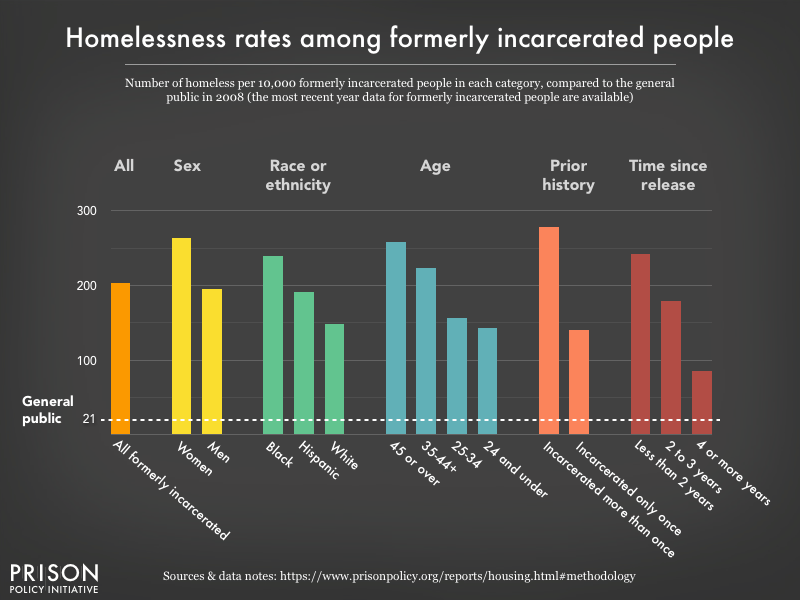
Report author Lucius Couloute explains that landlords and public housing authorities “have wide discretion to punish people with criminal records long after their sentences are over.” Couloute lays out policy solutions to what he calls a “fixable” problem, including:
- Regulating competitive housing markets to prevent blanket discrimination;
- Creating statewide reentry systems to help recently-released Americans find homes;
- Ending the criminalization of homelessness in U.S. cities;
- Expanding social services for all homeless people, with a “Housing First” approach.
Today’s report is the second of three to be released by the Prison Policy Initiative this summer, focusing on the struggles of formerly incarcerated people to access employment, housing, and education. Utilizing data from a little-known and little-used government survey, Couloute and other analysts can describe these problems with unprecedented clarity. In these reports, the Prison Policy Initiative recommends reforms to ensure that formerly incarcerated people – already punished by a harsh justice system – are no longer punished for life by an unforgiving economy.
As our research as shown, companies like JPay gouge people who are already overcharged and underpaid.
by Wanda Bertram,
August 8, 2018
In prison, you can be overcharged to send an email – something tricky to explain to people on the outside. On Marketplace this week, Victoria Law breaks down how companies like JPay have managed to turn email into a paid service.
JPay’s service is cheap, Law says, “but not necessarily a great deal.” As we’ve explained in the past, JPay gouges people who earn almost nothing, and who are already overcharged for services like medical care.
Below is the transcribed radio interview in full:
- Kai Ryssdal:
- A lot of people probably heard of a company called JPay for the first time last week. It’s a technology company, in a way, that operates in prisons in more than 20 states, but it was the Idaho State Correctional System that made headlines after 364 inmates hacked into JPay’s system to steal $225,000 worth of JPay services. Victoria Law has been covering JPay for WIRED and we got her on the phone for a bit more on this story. Welcome to the program.
- Victoria Law:
- Thanks for having me.
- Kai Ryssdal:
- So explain to me a little bit, would you, what this service is that JPay provides.
- Victoria Law:
- JPay provides a number of services. One of those services is “e-messaging,” which is a rudimentary form of email. So if you think about email, say back in the early to mid 1990s, it’s that kind of email, where it’s plain text. You can’t say go from your email to Google or Facebook or something else. JPay charges a fee which they call a “stamp” per page, and a page is roughly 500 words. So if you were, say, to send a long letter, you would have to buy multiple “stamps.”
- Kai Ryssdal:
- Right. And it replaces, in theory, phone calls – of which there has been much in the news of late about how they’re being made more expensive by Bureau of Prisons policy – but also I imagine regular old snail-mail, right?
- Victoria Law:
- Yes. For many people, JPay even though it is expensive, it is still cheaper than the price of a prison phone call, which can be anywhere from $.20 or $.21 per minute to as much as $18 for a 20-minute phone call.
- Kai Ryssdal:
- Wow!
- Victoria Law:
- So JPay is still cheaper, but it is not necessarily a great deal. If you think about the postal service, you can put your letter plus three photos of a family reunion or a new baby into an envelope, throw a stamp on it, throw in the mailbox and that’s it. With JPay you would have to pay for the letter, and then for each photo individually.
- Kai Ryssdal:
- There are probably no consumer satisfaction surveys for JPay…But do you know, what the inmates think about it versus the way it used to be?
- Victoria Law:
- First of all, JPay, when it contracts with a state prison system, that is the only company that has e-messaging.
So it’s not like on the outside where if you don’t like Yahoo or whatever, you go to Gmail, you either use the contracted e-messaging company whether it is JPay or one of its competitors, or you don’t use e-messaging at all.
So for many people they use it because that is their only choice, but they also note that, say, if their family member is elderly or doesn’t have a computer, it then makes it much more difficult to communicate because prisons that have contracted with JPay have also used this as an opportunity to cut down on the kinds of mail that people can get.
- Kai Ryssdal:
- A word here about the cost of these things, of this service rather, and you lay it out pretty well in this article, but $.47 inside a prison is not the same as $.47 outside the prison.
- Victoria Law:
- No, you have to remember that the majority of people in prison, if they are working a job in the prison, make something around $0.12 an hour. That money has to pay for not only things like JPay, but also necessities like aspirin – or in many prisons they charge a co-pay for a medical visit. So it falls largely upon the family members of people who are inside jails and prisons to cover these costs.
- Kai Ryssdal:
- Victoria Law writing about JPay most recently in WIRED. Her book about part of the prison complex in this country is called Resistance Behind Bars: The Struggles of Incarcerated Women. Victoria, thanks a lot for your time. I appreciate it.
- Victoria Law:
- Thanks for having me.
Stories about prison tablets are becoming more common. We offer tips to newsrooms for covering this issue fairly.
by Wanda Bertram,
August 2, 2018
This month, while we were uncovering the hidden costs of JPay’s “free” prison tablets, people incarcerated in Idaho were discovering something else: a way to “hack” JPay’s software to transfer credits to their own accounts.
It’s never certain how a story like this will be covered in the news, or how readers will react. But on Twitter, readers overwhelmingly sympathized with the “hackers” behind bars:
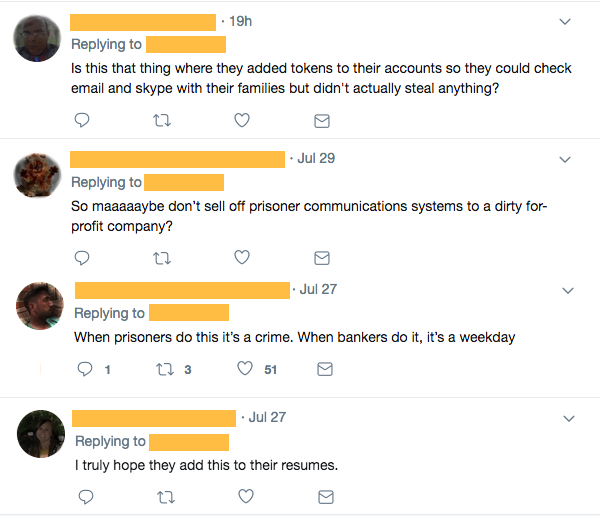
We tip our hats to readers who intuitively put this story into perspective. However, some news sites missed the point, with headlines like “Prison inmates hacked into tablets to steal nearly a quarter-million dollars,” or “Inmates ‘Hack’ Prison-Issued Tablets, Swiping $225,000 in In-App Bucks for Music and Games.”
For newsrooms covering prison tablets, we have some suggestions:
- Be wary of describing prison retailers the way they describe themselves. A company that “provides inmates with access to the outside world” at no cost to taxpayers sounds good, but what if that company sustained itself by grossly overcharging people in prison?
- If you’re talking about credits, don’t say “dollars.” A “quarter-million dollars” in tablet credits buys a lot less than you’d expect (see #3 and #4).
- Explain that the credits aren’t just for music and games. People in prison are also charged for video chats, email and money transfer – things that cost you and me almost nothing. Most of the Idaho hackers gifted themselves $1,000 in credits (or less). That amount – at least in other states whose contracts we’ve studied – buys less than 60 hours of video chat.
- Don’t forget to explain that these systems are unlike anything in the free world. The economy for digital services in prison is broken, with prisons often offering monopoly contracts to providers that will charge customers the most.
Finally, a general tip for covering the prison business: Talk to incarcerated people and their loved ones. For those forced to use JPay, the big story may not be the “exploitation” of vulnerable software, but the company’s ongoing exploitation of vulnerable families.
In our rebuttal to Securus, we disprove the company's claims of healthy competition in the prison phone market.
by Aleks Kajstura,
July 31, 2018
Two weeks ago, the Prison Policy Initiative, along with the Wright Petitioners and other advocates, called on the Federal Communications Commission to stop the merger of prison phone companies Securus and ICSolutions. Following Securus’ reply, we filed a rebuttal today demonstrating why the company should not be allowed to acquire its last effective competitor for prison and jail phone contracts.
Securus tried to argue that there’s still plenty of competition left in the market. The company quibbles over the methods we used to calculate its future market share (should it acquire ICSolutions). But the math here is not really that complicated: When a giant industry player acquires a competitor, there is immediately one less player, which reduces competition.
And competition in the prison phone market is more important than ever. Prisons and jails are finally starting to pay serious attention to the rates shouldered by incarcerated people and their families, taking these concerns into account when they choose a phone provider.
Securus, meanwhile, “continues to engage in charging unlawful and egregious rates,” as well as enabling illegal cell phone tracking. Securus is asking the FCC to look the other way as it acquires one more of its competitors. It must be prevented from expanding its frontier for misconduct.
For our detailed analysis of why Securus/ICSolutions are wrong about diversity of competition, and barriers to entry and expansion in the prison and jail phone market, see Exhibit D of our filing.
In a follow-up to our commissary report, we look at Texas commissary vendors and discover some surprising findings alongside the usual suspects.
by Stephen Raher,
July 26, 2018
One of the original inspirations for our report on prison commissaries earlier this year was a 2010 article from the Texas Tribune that analyzed $95 million in purchases at prison commissaries in the previous fiscal year. Because of the solid information already contained in the Tribune article, we chose not to use Texas as one of our sample states. But given the size of the Texas prison system, it seemed important to conduct some kind of review of commissaries in the Lone Star State.
This time, we looked at the sources of goods rather than spending patterns among incarcerated people, and discovered a couple of surprising findings alongside the usual major vendors.
The data
Using spending data available through the office of the Texas Comptroller, we were able to get a sense of where the state prison system buys commissary goods. Although there is no way to isolate commissary spending specifically, the Texas Department of Criminal Justice (TDCJ) lists its expenditures by category. One expense category is “cost of goods sold–merchandise for resale,” and it’s a reasonable guess that all or nearly all of this spending is for commissary inventory.1 In Fiscal Year 2017, TDCJ reported $77.6 million in purchases in the merchandise-for-resale category, which is roughly in line with what one would expect to see in a system that generates around $100 million in annual sales.
Our findings
Even though the purchasing data is only broken down by general category, there are a few observations and questions that emerge:
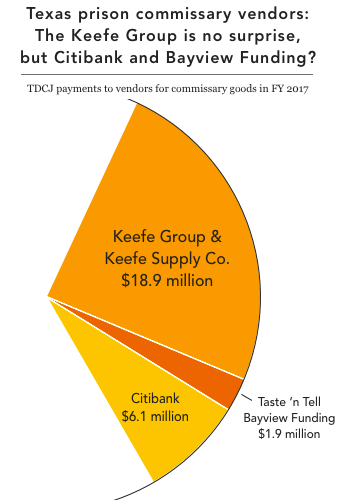
- Once again, Keefe is king. As we noted in our commissary report, even in states (such as Texas) that have not privatized commissary operations, the large commissary companies can still make money. Case in point: the largest single vendor in the data we examined was Keefe, accounting for nearly $19 million in inventory spending (about a quarter of all of TDCJ’s commissary purchases for the year).
- But why is Citibank making money on commissary too? Oddly, the third largest vendor by dollar-amount is Citibank, accounting for slightly over $6 million in purchases. This is a bit surprising, since Citibank doesn’t really sell “merchandise.” There’s no quick way to find out what this money is for – some of it could be money orders purchased by incarcerated people, but it could also be some kind of transaction fees, digital services sold to incarcerated people, or an actual product sold by Citibank. In any case, the point is: Citibank is receiving a big chunk of money from the Texas commissary system.
- And most mysterious of all, we have the curious case of Taste ‘n Tell International. Among the fifteen largest vendors in in the FY 2017 purchase data is a company called Taste ‘n Tell International, LLC, which received $1.9 million in payments from TDCJ in FY 2017. This company jumps out because it shipped goods to TDJC and issued invoices, but the state sent its payments to a financing company called Bayview Funding. This is because Taste ‘n Tell had obtained cash under a “factoring agreement” – a business financing arrangement where a financial firm (in this case, Bayview) purchases accounts receivable from an operating company (Taste ‘n Tell) at a discount from face value. Bayview makes money by pocketing the difference when the customer (TDCJ) pays.
Factoring by Taste ‘n Tell is a bad sign. Factoring is generally more expensive than traditional business financing options like bank loans. As a result, it is often used by new companies that lack a track record of profitability, or by companies in financial distress. Taste ‘n Tell is not particularly new (it was formed in 2008), but its financial affairs do look a bit rocky. Public records show that the company has been on the losing end of five lawsuits since 2012, with total judgments reaching almost $200,000. The company’s apparent owners have both filed personal bankruptcy petitions in the past, and the company’s headquarters appears to be a private residence in St. Louis.
Taste ‘n Tell’s use of factoring matters because it likely impacts the prices it charges TDCJ, which in turn impacts the prices charged to incarcerated people through the commissary. Are people in Texas prisons paying inflated prices in order to help Taste ‘n Tell get quick cash from a factoring company? That requires a closer look at what TDCJ is buying.
A sampling of invoices from FY 2017 shows that TDCJ purchases hygiene and food products from Taste ‘n Tell. Many of these items are not sold to the general public, making price comparisons difficult, but there are a couple of items that allowed us to shop around. First, in June 2017, TDCJ bought approximately 265,000 Femtex brand tampons (in cases of 480) from Taste ‘n Tell, for $45 a case (or 9¢ per tampon). The same brand of tampon retails for basically the same price on Amazon. The second example comes from June 2017 when TDCJ ordered 1,200 cases of Encore Premium garlic powder (12 bottles per case) for $9.24 a case (or 77¢ per bottle). The same brand is available for less (69¢ per bottle) to others who order in bulk from a wholesaler.
So why is Texas doing business with Taste ‘n Tell? Available data suggests that Taste ‘n Tell isn’t providing bargains. So why else would TDCJ be doing business with a small company that has a track record of not paying its bills? It’s hard to say. Perhaps Taste ‘n Tell satisfies some procurement quota for small or minority-owned businesses. Maybe the company is owned by people who have the right political connections. Or Taste ‘n Tell could actually have submitted the lowest bid.
Whatever the reason, the Taste ‘n Tell example is another reminder that commissary customers can’t hunt for the best price–they are captive to purchasing managers who often end up signing off on head-scratching deals like the Taste ‘n Tell purchases.
There's no such thing as a free lunch - or a free tablet.
by Wanda Bertram and Peter Wagner,
July 24, 2018
If someone offered you a free computer, you’d rightly be suspicious that there were strings attached. So when private companies offer “free” tablets to incarcerated people, politicians are understandably skeptical, looking for hidden costs to the state.
But in their quest for an answer, politicians will often fail, as we saw in New York State earlier this year. Private company JPay signed a contract with the New York Department of Corrections to give free tablets to 52,000 incarcerated people. Facing questions from legislators, the department insisted – truthfully – that taxpayers wouldn’t pay a dime.
Legislators dropped the issue without asking the bigger question: What would motivate a company to give away 52,000 tablet computers for free?
We filed a public records request, and got a more complete answer: The 52,000 “free” tablets are part of a package deal (or “bundled contract”) of several JPay services that gouge incarcerated people and their families.
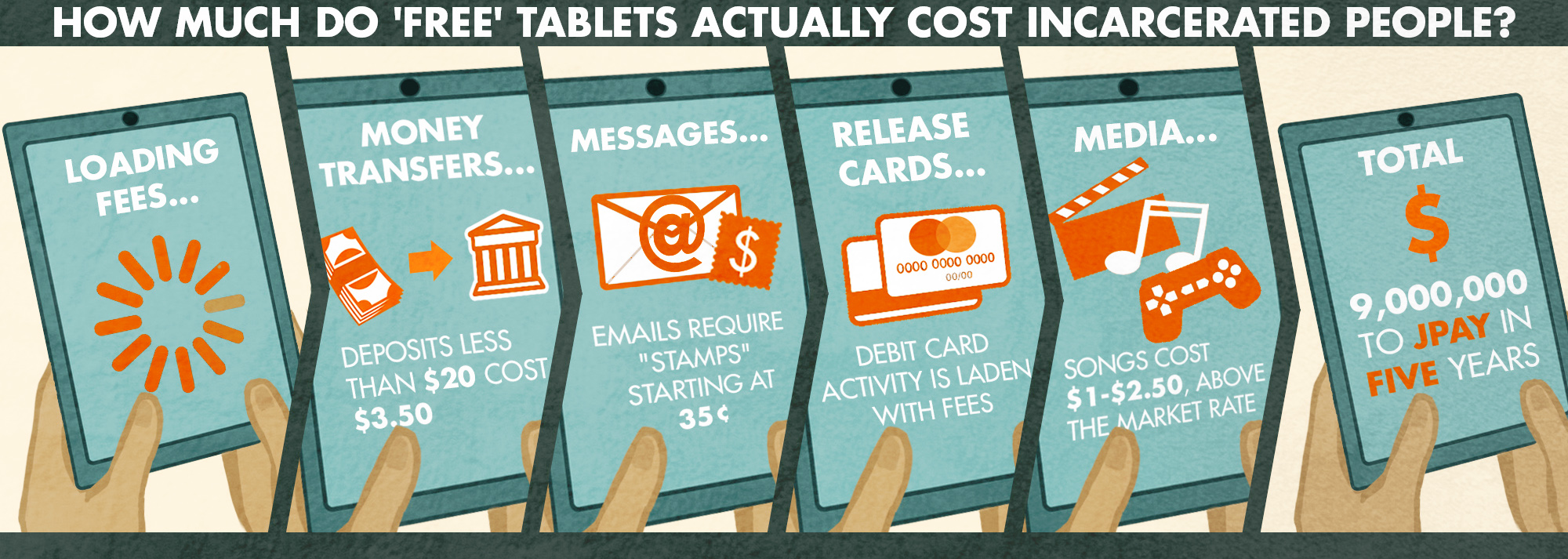
The contract contains virtually every exploitative trick we’ve documented in the past several years, including:
- Taking over the state prisons’ banking system, so they can add fees for services like depositing money. Transferring just $10 to a loved one’s account in a New York state prison will soon cost between $3.15 and $4.15.
- Selling $0.35 “stamps” for a product they have the nerve to call email. (We all have a love/hate relationship with our inboxes, but calling prison messaging email is not fair to email.)
- Providing refunds to incarcerated people when they are released, not in a check, but via a pre-paid debit card rife with fees – such as monthly “service” fees, fees for checking your account balance, or automatic fines for inactivity. (You can request a paper check instead – for $10.)
- Offering video chats at $9 for every 30 minutes.
- Charging above-market prices for media, such as music and e-books.
These provisions explain how JPay expects to make almost $9 million in five years from a contract that is free to the state: by selling profitable, fee-laden services against “complimentary” products like tablets.
New York state legislators never bothered to solve this mystery, but it’s ironic how close some of them got. Take Republican Assemblyman Steve Hawley, who demanded: “If it’s this easy to encourage vendors to provide free tablets to inmates, why aren’t they being provided to our students?” The answer, as columnist Erica Bryant points out, is that students would never purchase a fake “stamp” to send an email to their parents.
Companies like JPay are offering “free” tablet programs to a growing number of states, and legislators should approach these offers with caution. You don’t need an advanced degree to find the hidden costs in New York’s “no-cost” contract. The trick is looking not only at taxpayer costs, but also at the exploitation of incarcerated people and their families.
New York City becomes the first jurisdiction to make calls home from jails free. Who else is going to follow this smart step?
by Peter Wagner,
July 19, 2018
Yesterday, the New York City Council made New York the first jurisdiction in the country to make telephone calls from its prisons and jails free. The city will not only give up the commission it currently makes on phone calls – it is going a step further and making the phone calls themselves free. This change will save the poorest families in the City of New York more than $8 million a year.
In many prisons and jails, calls home from jail are very expensive, costing up to $1/minute. Typically, the facilities grant one phone company a monopoly contract in exchange for the company sharing the revenue with the facility. Some jurisdictions, however, including the New York State prison system, have refused to accept kickbacks on contracts and have instead negotiated for lower rates. They argue (correctly) that giving up that income is a cost-effective investment in lowering recidivism.
Going further and just paying for the calls makes particular sense in jails, where people are either serving short sentences or are detained only because they are too poor to make bail.
This change will be a big deal for the families, but the cost may be quite modest for the system. For example, prison systems like Nebraska have proven that it’s possible to get the rates down to just over a penny a minute when they refuse to take a commission. The New York City jail has economies of scale over Nebraska’s prisons, and the city will be saving the vendor the expensive hassle of individually billing tens of thousands of families.
With this legislation, New York City has not only joined the ethical jurisdictions that are standing up for their poorest families – they have catapulted into the lead. Who will follow?
The legislation takes effect in 270 days, giving the city jail system time to negotiate a new telephone contract.
We argue that Securus' history of misconduct should make it ineligible to acquire competitor ICSolutions.
by Aleks Kajstura,
July 17, 2018
Yesterday, the Prison Policy Initiative joined the Wright Petitioners and other advocates in calling on the Federal Communications Commission to stop the merger of prison phone companies Securus and ICSolutions. If the FCC approves Securus’ acquisition of ICSolutions, it will effectively hand the market for prison phone services to Securus and its last major competitor, GTL. Our filing objects to the merger under the FCC’s “character and fitness” test.
Securus’ history of repeatedly flouting commission rules – including deliberately misleading the FCC during a similar review last year, for which it was punished with an unprecedented $1.7 million fine – should alone make it ineligible to purchase one of its competitors. The company has repeatedly tried to circumvent regulation in order to increase its profits from prison phone calls, and as recently as May was caught enabling illegal cell phone tracking.
Our filing includes a detailed analysis of the concentration of the prison and jail telephone industry. We calculated market share in two different ways; by either measure, Securus and GTL are poised to control between 74% and 83% of the market. Except for ICSolutions — which Securus is seeking to acquire – no other company has above 3% market share.
This diminished competition will give facilities less choice and less ability to draft contracts that truly meet their needs. Such a decline in the power of facilities to negotiate with the phones companies comes at a particularly bad time: when a growing number of facilities are finally seeking contracts that lower phone rates for the families of incarcerated people.
Securus and ICSolutions have until July 23rd to respond to our objections. The Federal Communications Commission will rule shortly thereafter, either allowing the license transfer to go ahead, rejecting it, or ordering a hearing.
Formerly incarcerated people overwhelmingly want to work, but they face huge obstacles in the job market.
July 10, 2018
Easthampton, Mass. – For the 5 million formerly incarcerated people living in the U.S., landing a job means more than just personal success: It means finding a place in their communities and being able to care for their loved ones again.
It’s well known that the obstacles to finding a job are severe for formerly incarcerated people. The scale of this problem, however, has been difficult to measure – until now.
In Out of Prison & Out of Work, the Prison Policy Initiative calculates that 27% of formerly incarcerated people are looking for a job but can’t find one:
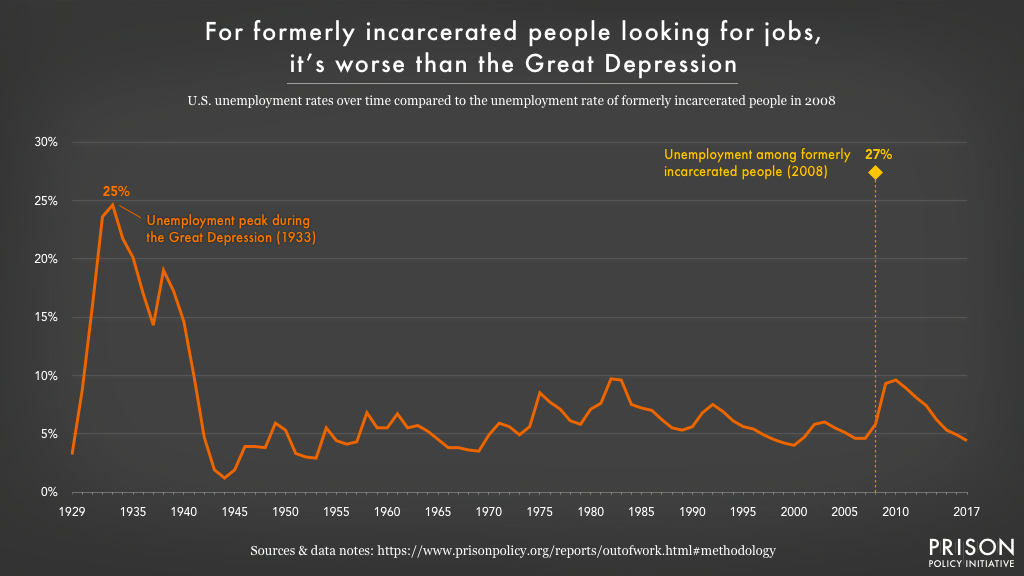
This rate, which surpasses anything Americans have experienced since the height of the Great Depression, is especially striking given the report’s other findings:
- Formerly incarcerated people are more likely than the average American to want to work;
- People of color and women face the worst “penalties” in the job market after going to prison, making historical inequalities in the labor force even worse;
- Unemployment is highest for people released in the last two years, when they are most vulnerable to re-incarceration.

“These high unemployment rates reflect public will, policy, and practice – not differences in aspirations,” said author Lucius Couloute. In the report, he lays out policy solutions for closing this vast employment gap, including:
- A temporary basic income for formerly incarcerated people after their release;
- Automatic mechanisms for criminal record expungement;
- Occupational licensing reform at the state and industry levels.
Today’s report is the first of three to be released by the Prison Policy Initiative this summer, focusing on the struggles of formerly incarcerated people to access jobs, housing, and education. Utilizing data from a little-known and little-used government survey, Couloute and other analysts can describe these problems with unprecedented clarity. In this report and the two more to follow, they recommend reforms to ensure that formerly incarcerated people – already punished by a harsh justice system – are no longer punished for life by an unforgiving economy.










